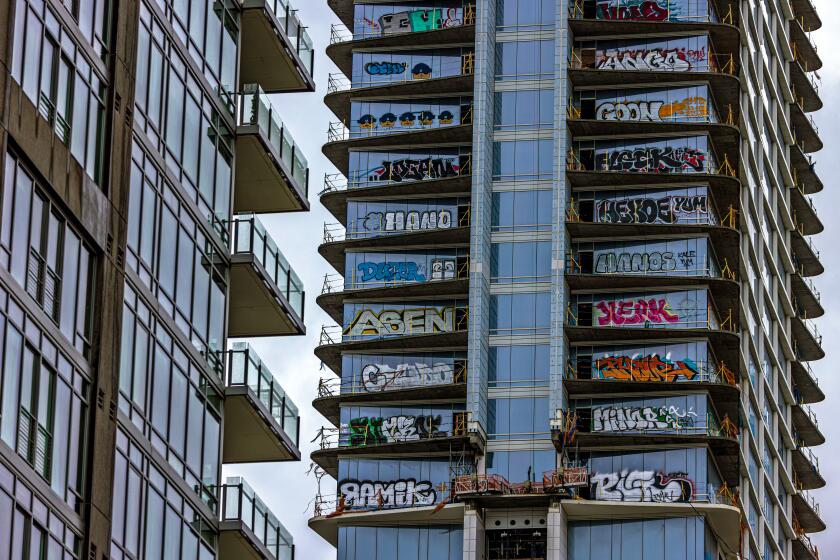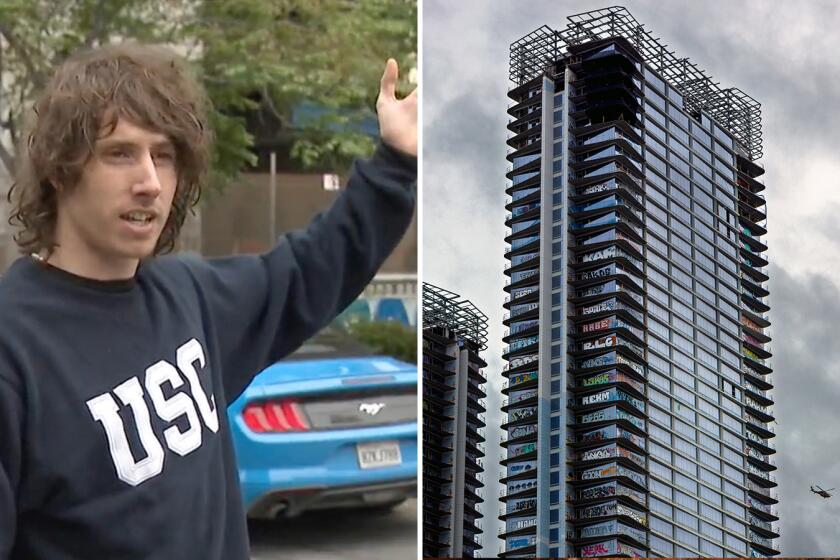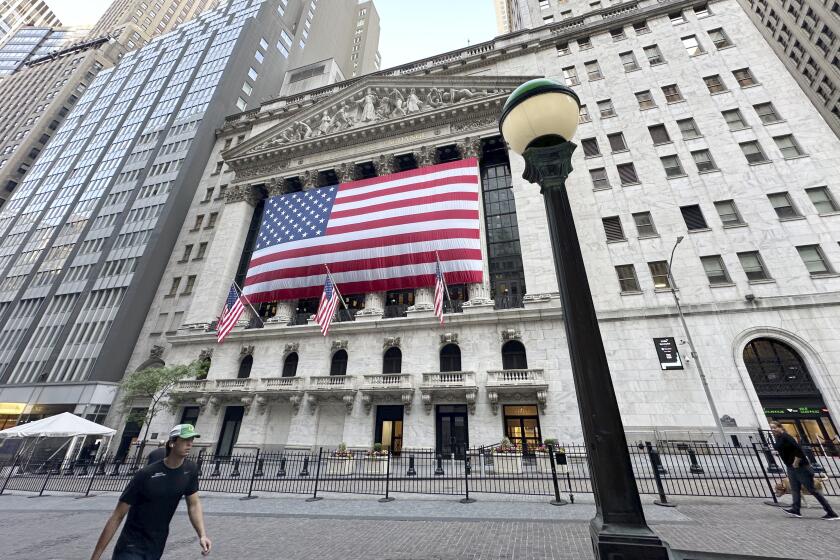Forget the graffiti. L.A.’s most notorious skyscrapers have a much bigger problem
Taggers were caught vandalizing the high-rise project in this drone video from Feb. 1, 2024. (Robert Gauthier / Los Angeles Times)
It was the graffiti that made the abandoned skyscrapers of Oceanwide Plaza in downtown Los Angeles infamous.
But the illicit work is low on the list of problems facing the bankrupt, billion-dollar development. With a potential fire sale of the residential, hotel and retail project approaching, a far more complex and expensive question looms over one of the region’s all-time real estate catastrophes: Can it be saved from the wrecking ball?
The fastest path forward for a new owner would be to complete the original plans for the three-tower development that ground to a halt in 2019 and stands about 60% finished. But some potential buyers and construction experts say that doing so is financially untenable, in large part because tenants would be scarce for the expansive retail space on the project’s bottom floors and a redesign would be very difficult for the oversized residential spaces in the towers above.
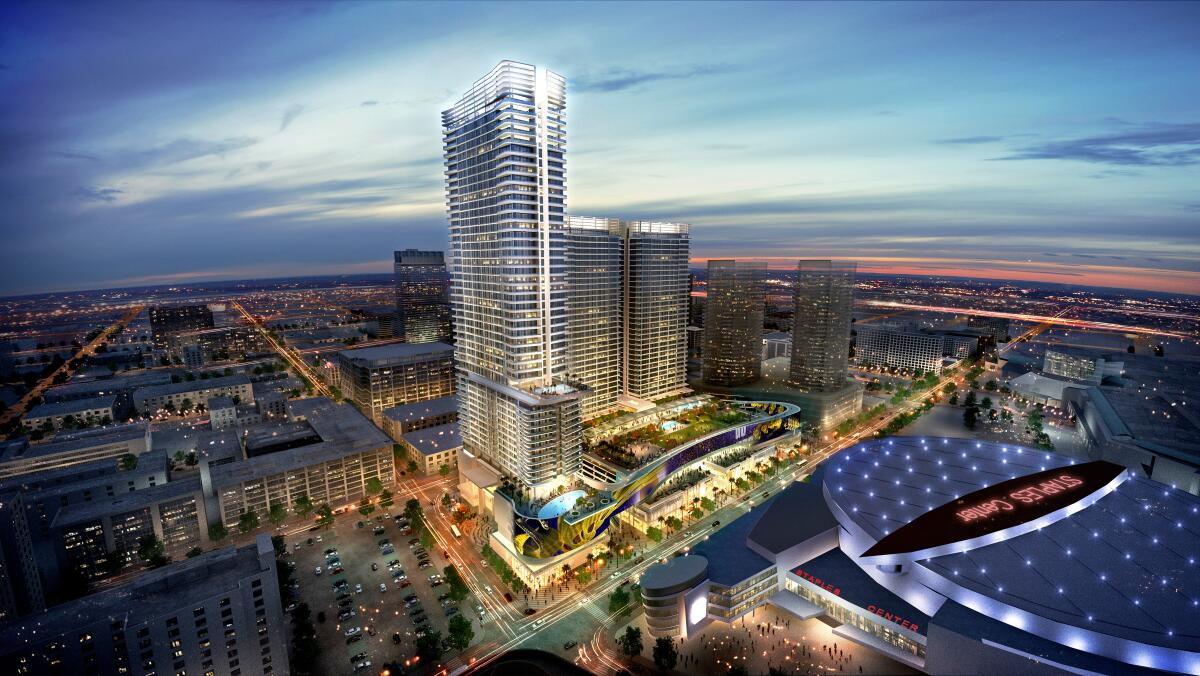
Instead, they say, the structures should be torn down to make way for something new.
“Believe me, somebody would have jumped forward with a viable plan if there really was one,” said developer Bill Witte, chief executive of Related California. Witte said he believes Oceanwide has “negative value because of the scale and the indeterminate amount of work that would have to be done to complete it.”
In other words, he believes it’s not worth the risk to try to fix Oceanwide Plaza.
And yet an unfinished complex in a prime location remains a lure to a handful of real estate investors with deep pockets.

Subscribers get exclusive access to this story
We’re offering L.A. Times subscribers special access to our best journalism. Thank you for your support.
Explore more Subscriber Exclusive content.
Last week, a federal bankruptcy judge set a Sept. 17 auction of the property, saying there are several potential bidders.
An April appraisal that real estate brokerage Colliers submitted in the bankruptcy case estimated the market value of the project at nearly $434 million. Colliers also projected a cost of $865 million to complete the buildings.
Broker Mark Tarczynski of Colliers, who is overseeing the efforts to sell Oceanwide, rejects the notion that demolition is the only option. He predicted last month that whoever buys Oceanwide Plaza will finish it.
“It’s about two-thirds of the way done, with about $1.2 billion already invested in it,” he said, and is structurally sound, according to an engineer. “Why would you tear down a perfectly good project? It’s unimaginable.”
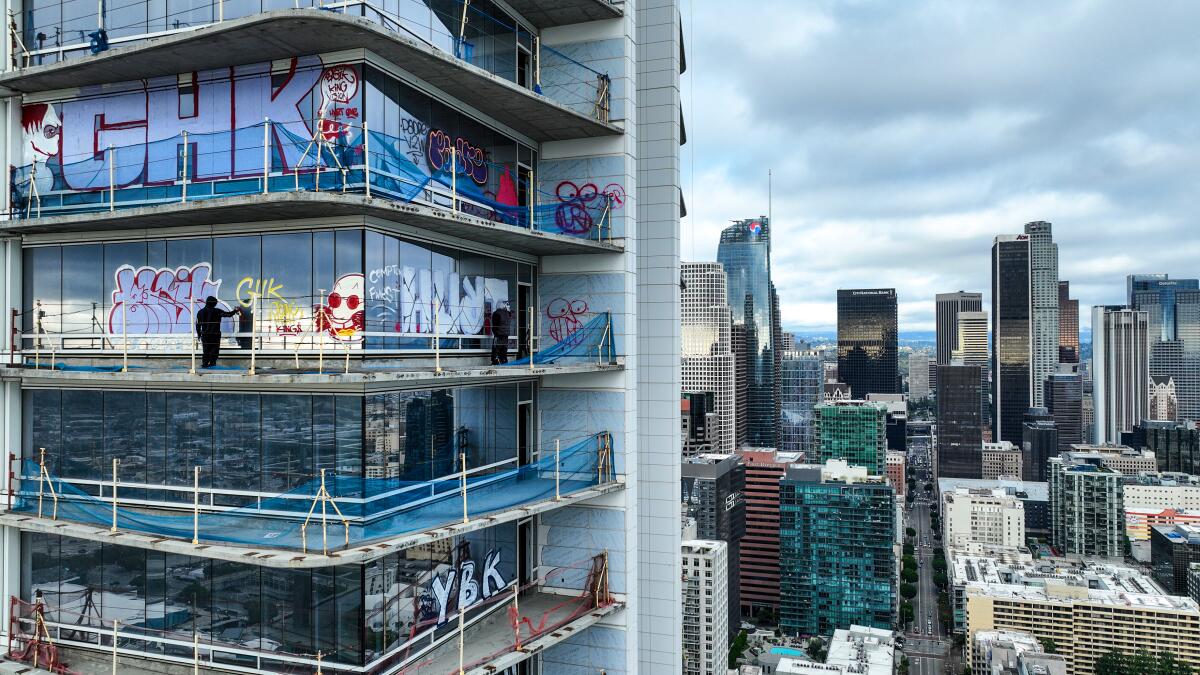
For now, Oceanwide Plaza stands out on the L.A. skyline, a graffiti-covered oddity on Figueroa Street — the wide thoroughfare that connects downtown’s financial district with L.A. Live, Crypto.com Arena and the Los Angeles Convention Center. It fills a large city block across the street from the arena — an A+ location in real estate terms for being in the midst of year-round activity.
The site was a sprawling asphalt lot used for event parking when Beijing-based Oceanwide Holdings bought it in 2014 with a vision to build a fancy, mixed-use development that was far bigger in scale than what is typically built in the U.S.
Oceanwide Plaza, the bankrupt, unfinished development in downtown Los Angeles that became a canvas for trespassing graffiti artists, is officially on the market.
Oceanwide set to work on the complex, which was intended to house luxury condominiums, a five-star hotel and an indoor mall that would include deluxe shops and restaurants. A massive electronic sign on its facade was to bring a flavor of Times Square to Figueroa Street.
When Oceanwide stopped paying building contractors in 2019 and work ceased, the construction site wasn’t all that much of an eyesore, said Javier Cano, the area manager for Marriott hotels in Los Angeles, who oversees the JW Marriott and Ritz-Carlton hotels at L.A. Live.
That changed early this year when graffiti artists began breaking into the property and turned its towers into a street art canvas, garnering worldwide headlines. The colorful images spray-painted on floor-to-ceiling windows stretch the height of the towers and are an inescapable sight from great distances.
“You get responses across the board, Cano said. “Some people believe it to be art, others believe it’s on the other end of the spectrum.”
The area remains busy with concerts and games, he said, but “we’re hoping something can get done one way or another” to bring the Oceanwide Plaza block back to life.
Stuart Morkun, vice president of development at Mitsui Fudosan America, was one of several developers who tried to figure out how to acquire and complete Oceanwide Plaza profitably but concluded it wasn’t feasible. As a builder of big projects including the recently completed Figueroa Eight luxury apartment skyscraper a few blocks away, he said he finds the project mesmerizing.
“It’s literally like walking into ‘Blade Runner,’” he said, referring to the 1982 film set in a dystopian future Los Angeles. “This postapocalyptic environment that could be from now or who-knows-when. It’s horrifying and thrilling to see at the same time.”
Graffiti in Los Angeles is a contentious subject. Artists and academics say focusing on the crime is missing the point.
Because the project has been exposed to the elements, including heavy storms, for years, Morkun said he was surprised at what he observed during a tour he took while considering whether to make an offer on the property.
“The concrete structure has held up fairly well,” he said, adding that he didn’t see much standing water or mold on the drywall and the aluminum and glass exteriors had stood up well to the weather.
That said, an unfinished construction project is full of unknowns, which can lead to problems, he said. “It would be daunting, as if you decided to pick up a pile of cards in a card game. You could be saying, ‘Holy smokes, what have I gotten myself into?’”
A major obstacle a new owner would face in trying to make Oceanwide Plaza financially viable is the design of the residential portions, which were intended to be filled with large, high-end condominiums. Oceanwide was expected to sell the condos primarily to Chinese residents looking for a place to invest overseas, but that pool of buyers shrank in 2017 while construction was underway, when the Chinese government restricted the flow of money out of the country. Large condos have proved a tough sell in Los Angeles, where wealthy buyers tend to prefer stand-alone homes.
Converting the residential space from big units to smaller, more affordable ones would be extremely difficult because of the way the floors are built, said architect Scott Johnson, who specializes in designing high-rise buildings, including the Figueroa Eight apartment tower downtown and office towers in Century City.

The builders used a common construction method for the floors called post-tension that involves pouring cement around taut steel cables that must stay intact even after the cement dries.
“We can’t take a floor that maybe has six huge units and then get 12 small units because every new toilet, every sink, every drain line, every vent would have to be cut into the slab, which has all these steel cables in it supporting it,” Johnson said. “The multiplication of units can’t happen here.”
If the number of units could somehow be multiplied, a new developer would also have to determine whether the buildings have enough elevators, parking spaces and other facilities to support increased occupancy, he said.
Challenges for using the property as designed go well beyond construction issues, real estate observers say, largely because there is so much space that would need to be leased or sold. Oceanwide came to L.A. with a plan on a scale more commonly found in China, where developments often dwarf projects in the West.
A performance artist who goes by the name Reckless Ben filmed himself on a slackline between two downtown L.A. skyscrapers 40 stories above Figueroa Street.
“The sheer scope of the project ... was unprecedented,” said Witte of Related California.
He described Oceanwide in its current state as “a carcass of an overscale development.”
Witte was behind downtown L.A.’s most recent mega-development — the Grand LA, designed by architect Frank Gehry. The complex on Bunker Hill contains 1.2 million square feet and cost $1 billion to build. In addition to high-rise apartment and hotel towers, it has 176,000 square feet of retail space that includes chef-driven restaurants.
More tenants have agreed to open there this year, but it still has ample empty retail space. The challenge of finding tenants would also be significant at Oceanwide Plaza, which has more than 160,000 square feet of retail space that would need to be filled with stores and restaurants or some other use.
The prospect of leasing that much space is daunting at a time when many shopping malls are suffering. Prospective buyers have reportedly considered a variety of solutions for Oceanwide’s shopping center, including turning it into a cosmetic surgery center.
Witte said he calculated before the pandemic that Oceanwide’s retail space could be converted to offices for rent, as has been done at other Los Angeles malls such as the Sherman Oaks Galleria and the Westside Pavilion. But with downtown office vacancy climbing, that option no longer makes sense, he said.
Morkun pursued a novel solution for Oceanwide’s retail conundrum: a casino. He envisioned the casino as one of a handful in the neighborhood that would form a small gaming district and perhaps help other real estate projects nearby get built.
“I saw how the Lakers could be part of an ownership group of the casino and have it branded and named Showtime Casino,” he said. “It’s just so natural right across from the arena. The sticky wicket is, how do you get a gambling license?”
Morkun researched how other cities such as Detroit have managed to bring in casinos in recent decades, but couldn’t crack California restrictions that limit gaming operations to the territories of federally recognized Native American tribes. The Gabrielino-Tongva Indian Tribe, whose ancestral lands include the Los Angeles Basin, is not recognized by the federal government, Morkun learned.
On the residential side of the equation, the units would have to be rented as apartments, not sold as condos, said developer and landlord Scott Dobbins, who oversaw construction of the $500-million Circa residential high-rise next to Oceanwide Plaza.
Condo owners often sue developers, alleging construction defects in their units or buildings. The long pause in construction at Oceanwide Plaza increases the risk of such claims and liability concerns manyfold, Dobbins said.
“I’m afraid that with a project that’s been sitting there for five years, you would get sued by so many owners,” he said. “Nobody is going to give you an insurance policy to protect you” from liability lawsuits.
Dobbins’ company, Hankey Investment Co., has been interested in acquiring the stalled development for years at what it considers the right price, “which has basically been zero,” he said.
Industry observers have put the price of knocking down Oceanwide Plaza at as much as $100 million, because it would be a painstaking slog. And any demolition, if it happened, could be historic in the city of Los Angeles. Real estate data provider CoStar reported that the city building and safety department said it doesn’t have records of any buildings demolished exceeding Oceanwide Plaza’s height and size.
A dramatic, explosive demolition of the sort used to level old Las Vegas casinos would be out of the question because it’s too close to other structures, demolition expert Ken TerBorch said.
It would have to be done gradually from the top down, said TerBorch, director of projects for Penhall Co. in Burbank, a construction contractor that does demolition.
“You’d get little excavators and little Bobcats and you’d remove a floor at a time,” he said, breaking it into pieces small enough to drop down a chute through an elevator shaft or some other opening. When the structures got low enough, large-scale excavators could be brought in to finish the job.
Subscriber Exclusive Alert
If you're an L.A. Times subscriber, you can sign up to get alerts about early or entirely exclusive content.
You may occasionally receive promotional content from the Los Angeles Times.
More to Read
Subscriber Exclusive Alert
If you're an L.A. Times subscriber, you can sign up to get alerts about early or entirely exclusive content.
You may occasionally receive promotional content from the Los Angeles Times.
